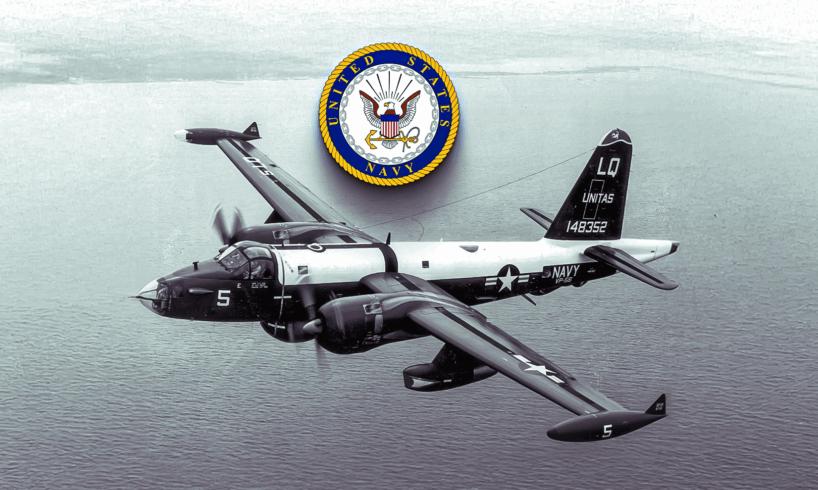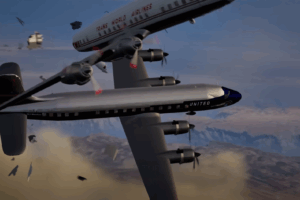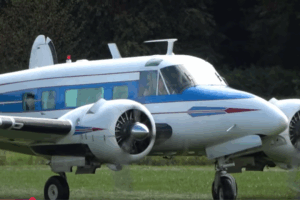
Few elements of naval warfare are nearly as complex as having submarine-finding aircraft. Submarine hunting is inherently a difficult task, and the amount of equipment needed to effectively track and deter submarine attacks on a naval fleet can be extremely challenging. As a result, several different submarine-hunting aircraft models have been developed over the years for the United States Navy.
The Lockheed
P-2 Neptune was one of the most successful submarine-hunting aircraft in history. This plane, which stayed in service long after it saw the Japanese Army and Navy surrender, was one of the most capable aircraft in its class to ever take to the skies. In this article, we will take a deeper look at the Lockheed P-2 Neptune, an all-capable multi-engine multirole reconnaissance aircraft and submarine hunter.
A Brief Overview Of The P-2 Neptune and What It Brought To The Table
Photo: United States Navy
The Lockheed P-2 Neptune was one of the most impressive pieces of engineering to enter service during the period surrounding the Second World War. The aircraft, which was previously designated as the P2V by the United States Navy in the years before September 1962, served as a maritime patrol and anti-submarine warfare (ASW) aircraft, according to the San Diego Air & Space Museum.
The plane was developed primarily for the United States Navy by Lockheed, and it was designed to replace the earlier Lockheed PV-1 Ventura and PV-2 Harpoon models which were already in service. The P-2 Neptune, a twin-engine aircraft, was eventually replaced by the Lockheed P-3 Orion, a model which remains in service in many capacities today.
A model originally developed as a land-based aircraft, the P-2 Neptune was never really designed to serve on aircraft carriers. The aircraft never made a landing on an aircraft carrier. A few models, however, were fitted with packages that allowed them to be carrier-launched, although these planes would eventually need to land on shore, or pilots would be required to ditch into the ocean. While designed initially for the United States Navy, the aircraft proved popular in export markets, eventually seeing service with multiple armed forces.
Related
A WWII Icon: How Effective Was The P-38 Lightning?
The P-38 was arguably one of the most effective fighters developed by the United States during WWII.
The Aircraft Was Designed To Meet The Navy’s Set Of Demands
Photo: United States Air Force
The development of a new land-based patrol bomber (one which would ultimately serve a multipurpose role) began early in World War II, with design work actually starting at Lockheed Vega on December 6, 1941. The development of this plane was ultimately planned as a private venture, mostly considered to be a low priority at the time in comparison with other aircraft programs.
The aircraft was developed at the same time as the Lockheed PV-2 Harpoon patrol bomber, which would serve roughly the same purpose. However, all of this changed on February 19, 1943, when the United States Navy signed a letter of intent for a pair of XP2V prototypes, models which were confirmed by a formal contract on April 4, 1944. A later 15 aircraft were ordered by the Navy just ten days later. It was not until 1944 that the aircraft program received the full green light.
The aircraft that was being developed needed to offer ease of maintenance, especially in a wartime environment. Keeping this design principle in mind has long been a key element motivating the aircraft’s success in global markets. The plane first took to the skies in May 1945, and production of the type formally began in 1946, with the plane formally entering service just one year later in 1947. The plane soon found a role serving as a versatile maritime aircraft.
The Aircraft Could Be Fitted With Multiple Kinds of Engines
Photo: United States Navy
The original P2V-5F model, the first to enter service, was one of the first operational aircraft to be capable of being fitted with both piston and jet-powered engines. Other, larger aircraft, such as the Convair B-36 Peacemaker, the Boeing C-97 Stratofreighter, and the Fairchild C-123 Provider, also offered these capabilities. Accommodating two separate propulsion systems, however, was quite a bit easier said than done, and it required Lockheed to create two completely different propulsion systems.
The Westinghouse J-34 jet engines would burn Avgas instead of jet fuel, and the jet pods on the aircraft were to remain closed when J-34 engines were not active. This meant that the aircraft could economically perform long-endurance search operations while having jet engines that could propel it to much higher speeds if combat or non-combat operational circumstances were required. According to normal US Navy operations, these engines were to run at full power during takeoff and then shut down once the plane reached altitude.
The crew had to access the jet via a small ladder in the nosewheel well, something unique that came as a consequence of the aircraft’s bizarre fueling system. These engines allowed the plane to achieve exceptional performance for an aircraft of its size. Here are some specifications for the Lockheed P-2 Neptune:
Category:
Lockheed P-2 Neptune Specification:
Maximum Takeoff Weight (MTOW):
80,000 lbs
Maximum speed:
363 miles per hour
Service ceiling:
22,400 feet
Total wingspan:
103 feet 10 inches
The Aircraft Boasts A Fascinating Operational History
Photo: RuthAS | Wikimedia Commons
The Lockheed P2V Neptune entered service with the United States Navy in 1947, first making the headlines as the Navy’s first purpose-built, land-based anti-submarine patrol aircraft. The plane replaced earlier World War II-era PB4Y Liberators, which had previously served as submarine hunters. The aircraft was mostly designed to serve as the “hunter” in a submarine hunter-killer package.
For these purposes, the plane was fitted with advanced equipment, including a magnetic anomaly detector and a belly-mounted AN/AOS-20 surface radar, which could detect submarines that were “snorkeling.” During earlier missions, some models were equipped with twin .50-caliber guns that could be replaced with forward observation bubbles for visual submarine identification. This could offer the aircraft one of two impressive capabilities. The aircraft would either be significantly better defended due to the additional armament, or it could also have additional places for visual observation of submarines. In areas with clear waters, this could be an extremely effective tactic.
In the late 1940s, some P2Vs were modified to serve as emergency carrier-launched nuclear bombers, capable of carrying Little Boy-style atomic weapons. The AJ Savage was eventually developed in 1952, mostly to serve this unique purpose. Cold War-era submarines had capabilities that far exceeded those of conventional submarines from the World War II era, so platforms like the P-2 needed to be upgraded. This ultimately led to the model’s retirement.
Some P-2 Models Were Modified For Specialized Missions
Photo: United States Navy
Like any multipurpose aircraft, the P-2 was exceptionally malleable, meaning that it could easily be modified to serve the needs of whatever mission was at hand. Some P-2 Neptune models were even modified by the Central Intelligence Agency (CIA) for specialized missions. A specially-configured P-2 model even set the global record for unfueled aircraft flight distance, with the plane flying over 11,200 miles. This model was famously known as “The Truculent Turtle,” according to the United States Navy.
The aircraft found commercial success in export markets, with the Royal Canadian Air Force, Royal Air Force Coastal Command, Royal Australian Air Force, and the Royal Netherlands Navy all operating the model at different points in time. The aircraft’s capability as a versatile, long-range maritime reconnaissance aircraft and submarine hunter ultimately proved invaluable.
By the time that the mid-1960s came around, the United States Navy’s many patrol squadrons had begun to process of replacing older P-2 models with the turboprop-powered P-3 Orion. Some Naval Reserve units, however, did operate SP-2H modified Neptune aircraft late into the 1970s.
Related
How Many Lockheed L-1011s Did Delta Air Lines Operate?
The carrier was the world’s largest operator of the unique trijet widebody aircraft.
The Aircraft Leaves Behind An Impressive Legacy
Photo: RuthAS | Wikimedia Commons
As one of the most capable submarine-hunting aircraft ever designed, it is not surprising that the P-2 Neptune left behind a legacy of operational excellence. The model served in pretty much every conflict the US was involved in at the time, and it was involved in dozens of different kinds of missions, underscoring its multimission capabilities.
During the Vietnam War, modified OP-2E variants originally served as unarmed gunships and sensor-deployment platforms. In almost every single experimental capacity over the years, the P-2 Poseidon had a role to play. All across the globe, the P-2 Neptune saw combat.
The plane was involved in the Falklands War, and the final Dutch P-2 left service in 1982. Japan’s license-built P-2 models remained on patrol well into the 1980s. Many P-2s found a second life as purpose-built tanker aircraft, which were often deployed across the globe as aerial firefighters.



